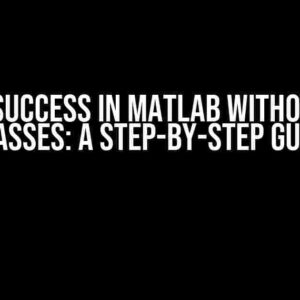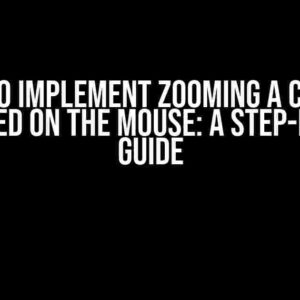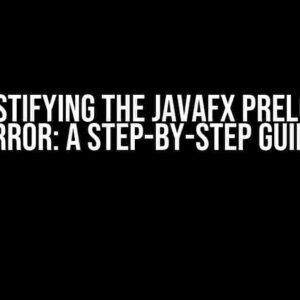Are you tired of dealing with confusing coordinates and struggling to pinpoint the exact location of your mouse on the screen? Do you wish there was a simple way to convert those pesky MouseX, MouseY values to the origin (0,0)? Well, buckle up, folks, because today we’re going to embark on a journey to demystify this daunting task and provide you with the ultimate solution!
What’s the big deal about MouseX, MouseY values?
The Problem: Understanding the Coordinate System
Imagine a 2D coordinate system, where the x-axis represents the horizontal position and the y-axis represents the vertical position. The top-left corner of the screen is considered the origin (0,0), and as you move the mouse pointer away from the origin, the MouseX, MouseY values increase.
| MouseX | MouseY |
|---|---|
| Increases as you move right | Increases as you move down |
The challenge arises when you need to convert these relative values to the origin (0,0), which is the primary focus of this article.
The Equation: Converting MouseX, MouseY to 0,0
Drumroll, please! The magic equation to convert MouseX, MouseY values to 0,0 is:
newX = MouseX - screen.width / 2;
newY = MouseY - screen.height / 2;Let’s break it down:
screen.widthandscreen.heightrepresent the width and height of the screen, respectively./ 2is used to find the midpoint of the screen, which is the origin (0,0).MouseXandMouseYare the original coordinates.newXandnewYare the converted coordinates, now relative to the origin (0,0).
Example Time!
Suppose we have a screen resolution of 1920×1080, and the mouse pointer is at (1200, 600). Let’s plug in the values:
newX = 1200 - 1920 / 2;
newY = 600 - 1080 / 2;
newX = 1200 - 960;
newY = 600 - 540;
newX = 240;
newY = 60;The resulting newX and newY values represent the converted coordinates, now relative to the origin (0,0).
Handling Edge Cases
What happens when the mouse pointer is beyond the screen boundaries? Fear not, dear reader, for we have you covered!
Handling Negative Values
When the mouse pointer is to the left or above the screen, the converted coordinates will be negative. This is perfect, as it indicates the correct position relative to the origin (0,0).
Handling Values Beyond the Screen
In cases where the mouse pointer is beyond the screen boundaries, you can simply clamp the converted values to the screen edges. This ensures that the coordinates remain within the screen’s bounds.
if (newX < 0) newX = 0;
if (newY < 0) newY = 0;
if (newX > screen.width) newX = screen.width;
if (newY > screen.height) newY = screen.height;Real-World Applications
This equation has far-reaching implications in various fields, such as:
- Game Development: Accurate mouse tracking is crucial in games, and converting MouseX, MouseY values to 0,0 allows for smoother gameplay and precise aiming.
- GUI Development: In graphical user interfaces, converting MouseX, MouseY values helps create intuitive and responsive interfaces.
- Data Analysis: When working with coordinate-based data, this equation enables you to normalize the values, making them easier to work with and analyze.
Conclusion
And there you have it, folks! The equation to convert MouseX, MouseY values to 0,0 is a powerful tool that can simplify your coding endeavors. By understanding the underlying coordinate system and applying this equation, you’ll be well on your way to creating more accurate and responsive applications.
Remember, practice makes perfect, so be sure to try out these examples and experiment with different scenarios to solidify your grasp of this concept.
Happy coding, and may the coordinates be ever in your favor!
Final Thoughts
If you have any questions or need further clarification on this topic, please don’t hesitate to ask in the comments below. Share your experiences and tips on using this equation in your projects, and let’s continue the conversation!
Stay tuned for more informative articles and coding guides, and don’t forget to bookmark this page for future reference.
Until next time, stay curious and keep coding!
Frequently Asked Question
Hey there, fellow coders! Are you tired of dealing with pesky MouseX and MouseY values? Well, buckle up because we’re about to dive into the world of coordinate conversions! Below, we’ve got the lowdown on how to convert those values to 0,0.
What is the equation to convert MouseX, MouseY to 0,0 in a 2D space?
Ah-ha! The magical equation to convert MouseX, MouseY to 0,0 in a 2D space is: new_x = MouseX – canvas.offsetLeft; new_y = MouseY – canvas.offsetTop; where canvas.offsetTop and canvas.offsetLeft are the top-left corner coordinates of your canvas element. Boom!
How do I find the top-left corner coordinates of my canvas element?
Easy peasy! You can find the top-left corner coordinates of your canvas element using JavaScript: const canvasRect = canvas.getBoundingClientRect(); const offsetX = canvasRect.left; const offsetY = canvasRect.top; Now you’ve got the values you need to plug into our trusty equation!
What if my canvas is inside a container element with padding or margins?
Good catch! If your canvas is inside a container element with padding or margins, you’ll need to take those into account when calculating the offset values. You can use the getBoundingClientRect() method to get the container’s offset values, and then add or subtract the padding/margin values as needed. It’s like solving a puzzle, but with code!
Can I use this equation for 3D spaces as well?
Hold up, partner! The equation I provided is specifically for 2D spaces. For 3D spaces, you’ll need to use a different set of coordinates and transformations. It’s like switching from a bike to a spaceship – you’ll need a new set of instructions to navigate the third dimension!
What if I’m using a framework or library that already has built-in coordinate conversion functions?
Lucky you! If you’re using a framework or library that already has built-in coordinate conversion functions, you can skip the manual equation and use the provided functions instead. It’s like having a superpower – you can focus on the fun stuff while the framework handles the heavy lifting!





